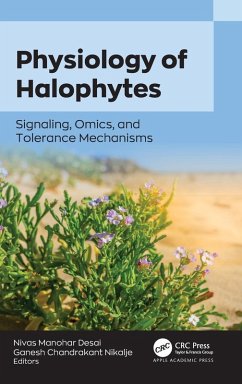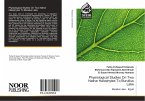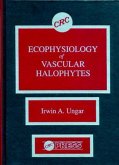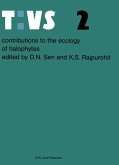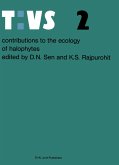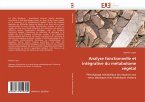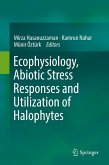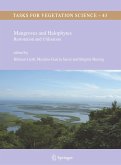Physiology of Halophytes
Signaling, Omics, and Tolerance Mechanisms
Herausgeber: Nikalje, Ganesh Chandrakant; Desai, Nivas Manohar
Physiology of Halophytes
Signaling, Omics, and Tolerance Mechanisms
Herausgeber: Nikalje, Ganesh Chandrakant; Desai, Nivas Manohar
- Gebundenes Buch
- Merkliste
- Auf die Merkliste
- Bewerten Bewerten
- Teilen
- Produkt teilen
- Produkterinnerung
- Produkterinnerung
Provides information on the mechanisms of plant responses to various environmental stresses. Covers molecular, biochemical, and physiological mechanisms behind salt tolerance on halophytes and saline adaptations. Overviews metabolomic, proteomic, and ionomic adjustment and adaptive mechanisms of halophytes under salinity stress.
Andere Kunden interessierten sich auch für
![Physiological Studies On Two Native Halophytes To Burullus Lake Physiological Studies On Two Native Halophytes To Burullus Lake]() Fathy El-Sayed El-GebalyPhysiological Studies On Two Native Halophytes To Burullus Lake49,99 €
Fathy El-Sayed El-GebalyPhysiological Studies On Two Native Halophytes To Burullus Lake49,99 €![Ecophysiology of Vascular Halophytes Ecophysiology of Vascular Halophytes]() Irwin A. UngarEcophysiology of Vascular Halophytes670,99 €
Irwin A. UngarEcophysiology of Vascular Halophytes670,99 €![Contributions to the ecology of halophytes Contributions to the ecology of halophytes]() SenContributions to the ecology of halophytes153,99 €
SenContributions to the ecology of halophytes153,99 €![Contributions to the ecology of halophytes Contributions to the ecology of halophytes]() Contributions to the ecology of halophytes161,99 €
Contributions to the ecology of halophytes161,99 €![Analyse fonctionnelle et intégrative du métabolome végétal Analyse fonctionnelle et intégrative du métabolome végétal]() Raphael LuganAnalyse fonctionnelle et intégrative du métabolome végétal49,99 €
Raphael LuganAnalyse fonctionnelle et intégrative du métabolome végétal49,99 €![Ecophysiology, Abiotic Stress Responses and Utilization of Halophytes Ecophysiology, Abiotic Stress Responses and Utilization of Halophytes]() Ecophysiology, Abiotic Stress Responses and Utilization of Halophytes75,99 €
Ecophysiology, Abiotic Stress Responses and Utilization of Halophytes75,99 €![Mangroves and Halophytes Mangroves and Halophytes]() Helmut Lieth / Maxímo García Sucre / Brigitte Herzog (eds.)Mangroves and Halophytes112,99 €
Helmut Lieth / Maxímo García Sucre / Brigitte Herzog (eds.)Mangroves and Halophytes112,99 €-
-
-
Provides information on the mechanisms of plant responses to various environmental stresses. Covers molecular, biochemical, and physiological mechanisms behind salt tolerance on halophytes and saline adaptations. Overviews metabolomic, proteomic, and ionomic adjustment and adaptive mechanisms of halophytes under salinity stress.
Hinweis: Dieser Artikel kann nur an eine deutsche Lieferadresse ausgeliefert werden.
Hinweis: Dieser Artikel kann nur an eine deutsche Lieferadresse ausgeliefert werden.
Produktdetails
- Produktdetails
- Verlag: Apple Academic Press Inc.
- Seitenzahl: 490
- Erscheinungstermin: 20. März 2025
- Englisch
- Abmessung: 234mm x 156mm
- Gewicht: 1100g
- ISBN-13: 9781774917350
- ISBN-10: 1774917351
- Artikelnr.: 71962896
- Herstellerkennzeichnung
- Libri GmbH
- Europaallee 1
- 36244 Bad Hersfeld
- gpsr@libri.de
- Verlag: Apple Academic Press Inc.
- Seitenzahl: 490
- Erscheinungstermin: 20. März 2025
- Englisch
- Abmessung: 234mm x 156mm
- Gewicht: 1100g
- ISBN-13: 9781774917350
- ISBN-10: 1774917351
- Artikelnr.: 71962896
- Herstellerkennzeichnung
- Libri GmbH
- Europaallee 1
- 36244 Bad Hersfeld
- gpsr@libri.de
Nivas Manohar Desai, PhD, is a Fellow of the Association of Plant Science Research as well as Assistant Professor of Botany and Plant Protection at Sadguru Gadage Maharaj College, Maharashtra, India. With over 15 years of experience in the field of plant science research, Dr. Desai has published international and national papers as well as many book chapters and edited eight books. His research areas are marine botany, plant physiology, functional foods, and photochemistry. He holds three Australian and six Indian patents. He has attended more than 30 international and national conferences. He is also the recipient of several young scientist awards and one research excellence award. Ganesh Chandrakant Nikalje, PhD, is an Assistant Professor of Botany at R. K. Talreja College, Ulhasnagar (affiliated to University of Mumbai), India. His major areas of resear ch are unravelling the salt adaptation mechanism of halophytes, development of bio-saline agriculture, phytoremediation, endophyte-assisted growth promotion and stress tolerance in plants, and assessment of wild vegetables for nutritional and value-added products. He is serving as an editor and reviewer for several international journals. He has been invited as a resource person for different conferences and symposia. To date, he has published three books, over 20 research/review papers in international journals, and over 16 book chapters in edited books for international publishers.
Foreword by Suprasanna Penna 1. Metabolomic Studies of Halophytes Under
Salinity Stress 2. Role of Halophyte-Microbes Duo in Environmental Clean-Up
3. Endophyte-Assisted Salinity Tolerance in Halophytes 4. Salt Signaling in
Halophytes 5. Metabolomic, Proteomic, and Ionomic Adjustment and Adaptive
Mechanism of Halophytes 6. Habitat, Growth Response, and Adaptation Under
Salinity in Sonneratia Sp. 7. Physiology and Potential Applications of Sand
Dune Halophytes 8. Physiological Responses of Halophytes to Salinity: A
Review 9. Adaptive Pathways of Halophytes and the Prospects of Increasing
Plant Salinity Tolerance 10. Halophilic Cyanobacteria and Microalgae: Role
in Environmental Clean-Up and Value-Added Products 11. Structural Hierarchy
Imparts Salinity Stress Tolerance Improvement in the Halophyte Sesuvium
portulacastrum L. 12. Halophytes: Prospectives and Perspectives for
Sustainable, Eco-Friendly, Environmental, and Agricultural Development 13.
Physiological, Proteomics, and Metabolomics Approaches for Elucidation of
Salinity and Alkalinity Tolerance of Halophytes 14. Reactive Oxygen Species
and Oxidative Damage in Halophytes Under Salt Stress 15. Halophyte
Adaptation is Nature's Prodigy for Environmental Changes 16. Adaptive
Strategies and Role of Endophytes in Halophytes for Amelioration of Salt
Stress 17. Potential Role of Halophytes in Environmental Clean-Up 18.
Halophytes as Reservoirs of Stress-Mitigating Proteins and Osmolytes 19.
Salicornia brachiata: A Potential Halophyte of Coastal Ecosystem Having
Ecological and Economic Significance
Salinity Stress 2. Role of Halophyte-Microbes Duo in Environmental Clean-Up
3. Endophyte-Assisted Salinity Tolerance in Halophytes 4. Salt Signaling in
Halophytes 5. Metabolomic, Proteomic, and Ionomic Adjustment and Adaptive
Mechanism of Halophytes 6. Habitat, Growth Response, and Adaptation Under
Salinity in Sonneratia Sp. 7. Physiology and Potential Applications of Sand
Dune Halophytes 8. Physiological Responses of Halophytes to Salinity: A
Review 9. Adaptive Pathways of Halophytes and the Prospects of Increasing
Plant Salinity Tolerance 10. Halophilic Cyanobacteria and Microalgae: Role
in Environmental Clean-Up and Value-Added Products 11. Structural Hierarchy
Imparts Salinity Stress Tolerance Improvement in the Halophyte Sesuvium
portulacastrum L. 12. Halophytes: Prospectives and Perspectives for
Sustainable, Eco-Friendly, Environmental, and Agricultural Development 13.
Physiological, Proteomics, and Metabolomics Approaches for Elucidation of
Salinity and Alkalinity Tolerance of Halophytes 14. Reactive Oxygen Species
and Oxidative Damage in Halophytes Under Salt Stress 15. Halophyte
Adaptation is Nature's Prodigy for Environmental Changes 16. Adaptive
Strategies and Role of Endophytes in Halophytes for Amelioration of Salt
Stress 17. Potential Role of Halophytes in Environmental Clean-Up 18.
Halophytes as Reservoirs of Stress-Mitigating Proteins and Osmolytes 19.
Salicornia brachiata: A Potential Halophyte of Coastal Ecosystem Having
Ecological and Economic Significance
Foreword by Suprasanna Penna 1. Metabolomic Studies of Halophytes Under
Salinity Stress 2. Role of Halophyte-Microbes Duo in Environmental Clean-Up
3. Endophyte-Assisted Salinity Tolerance in Halophytes 4. Salt Signaling in
Halophytes 5. Metabolomic, Proteomic, and Ionomic Adjustment and Adaptive
Mechanism of Halophytes 6. Habitat, Growth Response, and Adaptation Under
Salinity in Sonneratia Sp. 7. Physiology and Potential Applications of Sand
Dune Halophytes 8. Physiological Responses of Halophytes to Salinity: A
Review 9. Adaptive Pathways of Halophytes and the Prospects of Increasing
Plant Salinity Tolerance 10. Halophilic Cyanobacteria and Microalgae: Role
in Environmental Clean-Up and Value-Added Products 11. Structural Hierarchy
Imparts Salinity Stress Tolerance Improvement in the Halophyte Sesuvium
portulacastrum L. 12. Halophytes: Prospectives and Perspectives for
Sustainable, Eco-Friendly, Environmental, and Agricultural Development 13.
Physiological, Proteomics, and Metabolomics Approaches for Elucidation of
Salinity and Alkalinity Tolerance of Halophytes 14. Reactive Oxygen Species
and Oxidative Damage in Halophytes Under Salt Stress 15. Halophyte
Adaptation is Nature's Prodigy for Environmental Changes 16. Adaptive
Strategies and Role of Endophytes in Halophytes for Amelioration of Salt
Stress 17. Potential Role of Halophytes in Environmental Clean-Up 18.
Halophytes as Reservoirs of Stress-Mitigating Proteins and Osmolytes 19.
Salicornia brachiata: A Potential Halophyte of Coastal Ecosystem Having
Ecological and Economic Significance
Salinity Stress 2. Role of Halophyte-Microbes Duo in Environmental Clean-Up
3. Endophyte-Assisted Salinity Tolerance in Halophytes 4. Salt Signaling in
Halophytes 5. Metabolomic, Proteomic, and Ionomic Adjustment and Adaptive
Mechanism of Halophytes 6. Habitat, Growth Response, and Adaptation Under
Salinity in Sonneratia Sp. 7. Physiology and Potential Applications of Sand
Dune Halophytes 8. Physiological Responses of Halophytes to Salinity: A
Review 9. Adaptive Pathways of Halophytes and the Prospects of Increasing
Plant Salinity Tolerance 10. Halophilic Cyanobacteria and Microalgae: Role
in Environmental Clean-Up and Value-Added Products 11. Structural Hierarchy
Imparts Salinity Stress Tolerance Improvement in the Halophyte Sesuvium
portulacastrum L. 12. Halophytes: Prospectives and Perspectives for
Sustainable, Eco-Friendly, Environmental, and Agricultural Development 13.
Physiological, Proteomics, and Metabolomics Approaches for Elucidation of
Salinity and Alkalinity Tolerance of Halophytes 14. Reactive Oxygen Species
and Oxidative Damage in Halophytes Under Salt Stress 15. Halophyte
Adaptation is Nature's Prodigy for Environmental Changes 16. Adaptive
Strategies and Role of Endophytes in Halophytes for Amelioration of Salt
Stress 17. Potential Role of Halophytes in Environmental Clean-Up 18.
Halophytes as Reservoirs of Stress-Mitigating Proteins and Osmolytes 19.
Salicornia brachiata: A Potential Halophyte of Coastal Ecosystem Having
Ecological and Economic Significance

